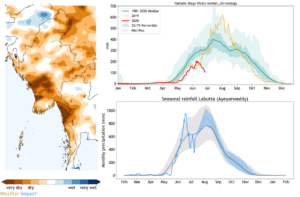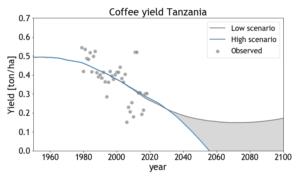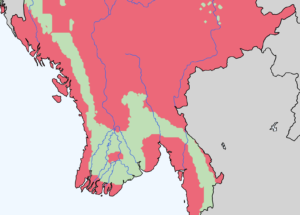Climate related risks
Climate is the largest contributor to agricultural yield variability in Africa, making climate change a topic of high importance. For many years, knowledge about the weather for agricultural practices is passed from generation to generation, however this knowledge cannot be applied anymore due to a changing climate.
For example, the start and intensity of the monsoon are shifted and weather extremes occur more often; having large consequences for farming practices.
Smallholder farmers are exposed to these changing weather risk, since they normally don’t irrigate their land; have limited options for crop protection; have low access to fertilizer and chemicals; and have limited insurance. Also larger plantations and companies are affected by climate change and they need to know whether future yields are still profitable enough to run their business.
Seamless forecasting
Climate risks play a role at different time scales:
1.) Present day: Is current climate normal? How often does temperature and precipitation extremes occur with regard to the last decade?
2.) Seasonal: will coming season be drier than normal? What will the expected yield be this season? To act, one can plant drought-resistant crops, plant their crops later than normal or adjust their agricultural practices. When the price is expected to drop coming months it can be strategic to store or sell their products at other times.
3.) Multi-year: How will the local climate change in future? Will your area still be suitable to grow certain crops in 20 years time? This is especially relevant for the planning of future production areas and sustainability of existing plantations.
At Weather Impact, we perform climate analyses at various time scales and also across time scales. This approach makes us unique, as we combine various data sources and models into one seamless product – which we call seamless forecasting -, tailored to your location.
Figure 1: Seamless forecasting couples various data sets into one congruent data set, tailored to a specific location or region.
Example 1: Status and seasonal weather projection
Current status of the season is important in combination with a seasonal weather outlook for planning farming activities and to project the expected yield for coming season. In Myanmar, we monthly issue a seasonal weather outlook. An example, a subset of the seasonal status for July 2020, can be seen in Figure 2. In this particular case the monsoon season of 2020 has started in almost the whole country. Yet the received rainfall is (much) less than normal.
Figure 2: Rainfall conditions over Myanmar compared to historic average for July 2020.
Example 2: Coffee yield in a changing climate
Coffee is a crop growing in semi-tropical regions. 70% of all coffee grown worldwide is the type Arabica coffee, making coffee products extremely vulnerable to climate change. Most optimal growing conditions for Arabica coffee beans are temperatures between 18-21 degrees Celsius but can tolerate annual mean temperatures around 24 degrees Celsius. Higher temperatures mean faster ripening of the coffee bean and degradation of the quality.
By combining historical yield data and seamless forecasting data one can find a relation between climatic conditions and coffee yield. This can be combined with climate projections to project the coffee yield in future. An example of such product for Tanzania is shown in Figure 3. The shaded area is the range in projected coffee yield outcomes for coming decades. This figure shows the coffee sector has an urgent problem for coffee plants in Tanzania as the projected yield decreases fast. Tanzanian farmers can adjust to future climate by switching to other coffee varieties before it is too late and coffee companies can find more climate suitable areas in Tanzania, which are more suitable for growing coffee in 20 to 30 years time.
Figure 3: Coffee yield prediction for Tanzania based on historical climate data and the range of future climate predicted by climate models. Please note this is a country average, regionally large differences are present.
Example 3: Climate suitability for rubber trees in Myanmar
Crops grow best under certain climatic conditions (precipitation, humidity, temperature) and can be sensitive to droughts for example or excessive rainfall. With this information the suitability of regions for a specific crop can be determined. This is extremely relevant for large existent plantations, as current locations can become unsuitable to grow the crops in a changing climate. On the other hand, if one must choose a new location for a plantation, it should be climate resistant. At Weather Impact we use climate models to locate suitable regions to grow specific crops. An example of such a product is shown in Figure 4.
Figure 4: Climate suitability for growing rubber trees in Myanmar. Suitable regions are indicated by a green colour, unsuitable regions by a red colour. We can also show future climate suitability and investigate which areas become more or less suitable than in today’s climate.
Contact us
Are you interested in these type of advisory products or you want to know more about our services? You can contact Pleun Bonekamp at pleun.bonekamp@weatherimpact.com.





